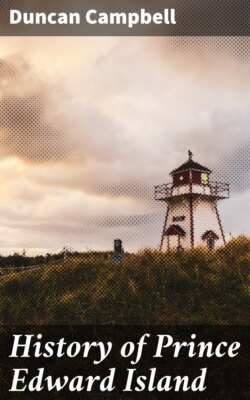History of Prince Edward Island

Реклама. ООО «ЛитРес», ИНН: 7719571260.
Оглавление
Duncan Campbell. History of Prince Edward Island
History of Prince Edward Island
Table of Contents
Отрывок из книги
Duncan Campbell
Published by Good Press, 2019
.....
Lieutenant-General Fanning’s connection with the island, as governor, terminated in 1804. During his administration the island did not make any remarkable progress in its various interests; but Mr. John McGregor—a native of the island, and of whom we shall have more to say by-and-bye—in his work on British North America, has hardly done the general justice, in representing him as of very “obscure origin, and owing his future to circumstances, the advantages of which he had the finesse to seize.” General Edmund Fanning was a native of America, and was born in the Province of New York, on the twenty-fourth of April, 1739. He was the son of James Fanning, a captain in the British service, and of his second wife Mary Smith, daughter of Colonel William Smith, who for some time administered the government of New York, and was sole proprietor of Smith Town, on Long Island. The paternal grandfather of General Fanning came to America, from Ireland, with Earl Bellemont, in 1699.
Captain James Fanning, having disposed of his commission while in England, returned to New York in 1748, when his son Edmund, then in the ninth year of his age, was sent to a preparatory school, and thence removed to Yale College, New Haven, where, after going through the regular course of collegiate studies, he received the degrees of Bachelor and Master of Arts; and in 1774 he was honored by the University of Oxford, England, with the degree of Doctor of Civil Law. From college he proceeded to North Carolina, where, after studying two years under the attorney general of that province, he was, in 1762, admitted to the bar. He was successful in his profession; but the troubles of the eventful period in America which followed the passing of the Stamp Act by the British Parliament, induced him to enter the civil and military service of his country. In 1765 he was appointed by Governor Tryon of North Carolina one of the Judges of the Supreme Court in that province in the room of Mr. Justice Moore, who was dismissed from office upon the supposition of his favoring the public commotions at the time existing in North Carolina. In 1768 he raised, at the request of Governor Tryon, a corps of eight hundred provincials to oppose and put down a body of insurgents who styled themselves regulators, whose object was to rescue from trial and punishment leading rebels. In 1771 he was again called upon by Governor Tryon to raise and embody a corps of provincials to suppress an insurrection in North Carolina, and was second to Governor Tryon at the battle of Allamance, in which action, the insurgents, to the number of twelve thousand, were totally defeated.
.....